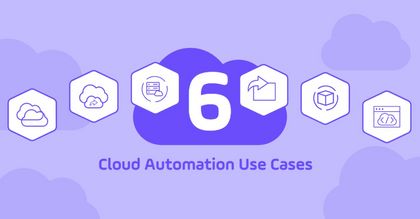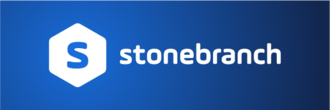6 Cloud Automation Use Cases Every IT Pro Should Know
Learn how enterprises are centrally automating cloud, multi-cloud, hybrid cloud, and containerized microservices.

Cloud automation use cases are relatively new. As a result, there is no uniform “this is how everybody does it” guide to explain what can be done, or how to do it. After all, just ten years ago, automation was almost exclusively done on-premises. Today, more than 90% of enterprises use a mix of public and private clouds, in addition to SaaS apps and their existing on-premises environment.
The good news is the possibility of automating processes and workflows dramatically increases with cloud adoption. This is especially true as it relates to multi-cloud environments, cloud infrastructure provisioning, transferring data, and containerized microservices. So, if your enterprise falls into the 90%, there are some seriously cool things you can do!
Cloud Automation Use Cases to Manage Complexity
Whether you are in IT Ops, on a data or development team, or working directly as a CloudOps professional, automating cloud processes can be a huge timesaver. You’re probably even using a mix of automation technologies today. The problem is that widely adopted tools — like native cloud schedulers and job scheduling solutions — simply don’t work together. As a result, you wind up with a bunch of siloed automated processes.
All that said, enterprises have turned to a newer way of orchestrating automated processes. Gartner introduced service orchestration and automation platforms (SOAP) as a formal category in 2020. This new breed of solutions is an evolution from the traditional workload automation (WLA) category. The most polarizing difference is that SOAPs allow centralized control of on-premises and cloud processes, whereas WLA is designed to only focus on-premises.
The six use case examples below illustrate how enterprises are using SOAPs as the backbone of their orchestration and automation programs. SOAPs are designed to integrate with, and then automate just about any cloud technology. If you want to get a sense of the types of pre-built integrations a SOAP will include, be sure to check out the Integration Hub.

Multi-Cloud Orchestration
Connect the automation dots between any cloud service, application, or database. Create and orchestrate cloud processes using visual workflows. Eliminate the need to manage siloed cloud environment automation tools.
Today’s multi-cloud approaches extend well beyond using multiple public cloud service providers (CSPs), such as Amazon Web Services (AWS), Google Cloud Platform (GCP), and Microsoft Azure. Most organizations also use a myriad of SaaS tools, cloud storage, infrastructure management, cloud-native database tools, and a whole lot more.
What’s the trick to automating multi-cloud environments? Realistically, the answer is to stop thinking about automation for individual systems. Rather, consider how you can connect each cloud tool as part of a larger workflow.
SOAPs allow you to orchestrate automation workflows visually. By mapping out workflows that connect automated processes between cloud tools, you’ll quickly see that the sum of the parts is much more powerful than the individual pieces. Additionally, it’s also easier to manage automation because you’re doing it from a centralized platform versus each separate tool.
Hybrid Cloud Data Transfer
Centrally manage data transfers between legacy on-premises systems and modern cloud applications — in real-time.
One of the biggest challenges in a hybrid cloud setup is moving data between on-premises environments and CSPs. This is especially true when on-premises data is regularly used by applications in the cloud or vice-versa.
Many SOAPs natively include managed file transfer technology. This powerful combination allows you to move data between on-premises, cloud, and containerized microservices. Like many schedulers in the market, data transfers can be scheduled in batches. However, SOAPs really shine by also enabling real-time transfers based on system events that are part of more complex workflows. Additionally, data transfers are possible both inside and outside your organization to allow maximum security, visibility, and performance.
Cloud Infrastructure Automation
Quickly provision, configure, and deploy complex infrastructure services across your hybrid environment.
There’s no shortage of automation solutions, whether the tool is built-in, cloud-based, or open-source. But how many enable your entire IT system to work as one unified force?
Most enterprises leverage infrastructure management, or cloud orchestration, tools like Puppet, Chef, Ansible, and Terraform. Each of these solutions (and their competitors) essentially manage similar but different parts of the cloud infrastructure world. They are not really designed to work seamlessly with each other, which leaves an orchestration and automation gap.
Two ways to leverage a SOAP for infrastructure automation:
- Meta-orchestrate the entire process by integrating with pure-play integration management tools. Using this approach, a SOAP centralizes the automated processes that are required both within the pure-play tools and between them. Like multi-cloud orchestration, visual workflows can be designed to help your team monitor, manage, and gain a whole new level of observability.
- Alternatively, if an enterprise does not use pure-play cloud infrastructure tools just yet, a SOAP can help directly manage infrastructure. Simply connect the SOAP to a cloud service provider and start creating workflows using infrastructure-as-code (IaC). To be clear, a SOAP is not designed to have all the bells and whistles that the pure-play vendors have. However, sometimes the bells and whistles simply are not needed.
Cloud Infrastructure-as-a-Service
Empower non-IT staff to turn cloud infrastructure on and off while maintaining central control and visibility.
Historically, business users have relied on IT teams to manage their department-specific tools and platforms. But that’s no longer necessary. Modern orchestration platforms enable infrastructure-as-code (IaC).
This level of automation is a win-win for everyone. End-users gain speed, and IT centrally controls which cloud provider and how much cloud infrastructure is used — while maintaining (or gaining) visibility into the whole process.
Simplify Cloud Migrations
Move workloads to the cloud — without ever missing out on the benefits of automation.
Traditionally, modifications to IT infrastructure mean rebuilding automation from scratch to ensure critical tasks execute in the correct environment. Manually re-calibrating workload definitions in this way are both time-consuming and resource-intensive.
Designed for hybrid IT environments, modern orchestration platforms offer real-time automation that allocates the resources needed to execute workloads at runtime — without ever changing workload definitions.
Containers / Microservices Automation
Seamlessly orchestrate containers as part of larger automated workflows. Plus, easily connect to and automate applications within a container.
Containerization and microservice architectures strip applications down to specific functions for temporary usage. Without a centralized automation solution, these transient environments (and their related management platforms) can be difficult to coordinate.
By integrating with container technology, like Docker and Kubernetes, SOAPs help centralize the orchestration of containers and the applications within them. This approach makes it really easy to automate
- Container deployment based on real-time events
- Microservice execution of the applications within the container
- Data transfer from or to containers
- Container removal to reduce virtual sprawl
Summary
Yes, the cloud is still in its youth. But if you’re like 90% of enterprises out there, you don’t have to be. While it’s possible to automate parts of the cloud in silos, a SOAP is designed to help extract value from the sum of the parts.
If you’d like to dive deeper into each of these use cases, be sure to download this complete whitepaper. The paper offers diagrams and additional details. Plus, you’ll see examples of which cloud technologies our customers connect today, to gain maximum value.
Start Your Automation Initiative Now
Schedule a Live Demo with a Stonebranch Solution Expert






